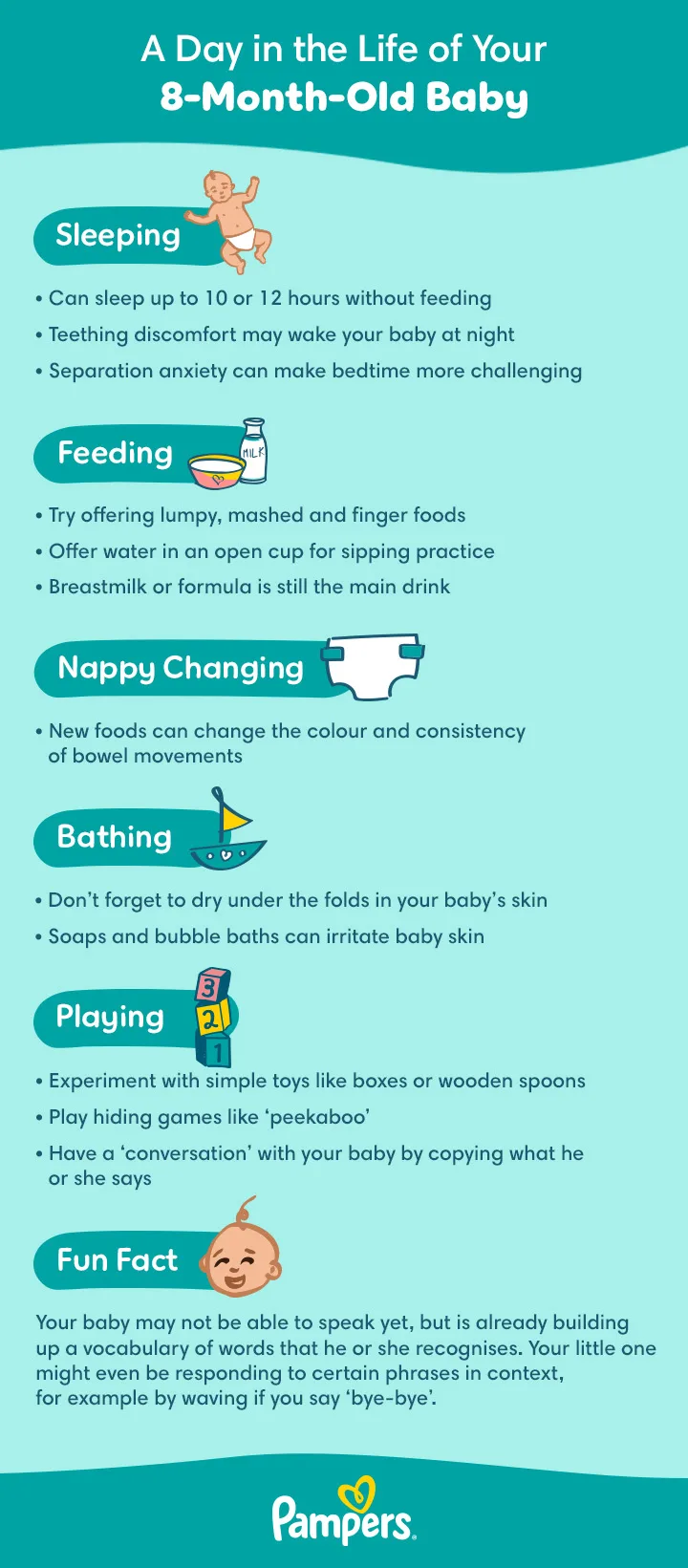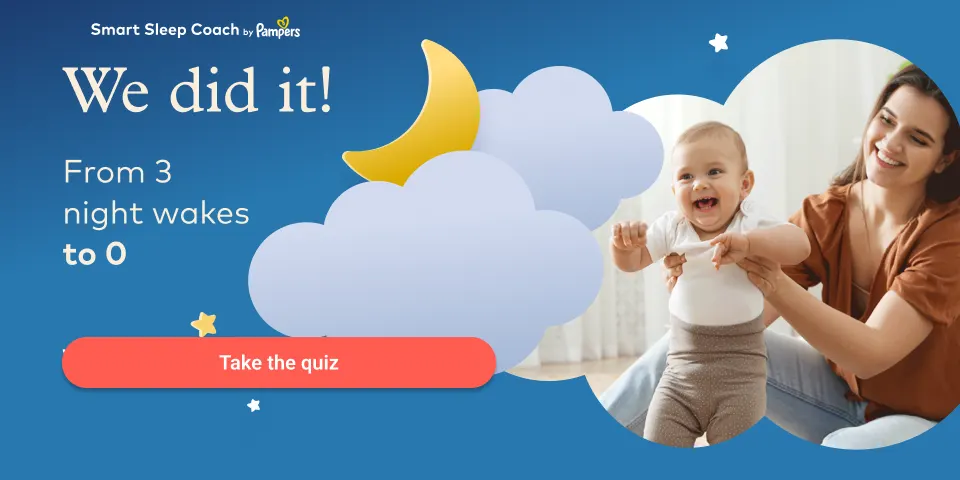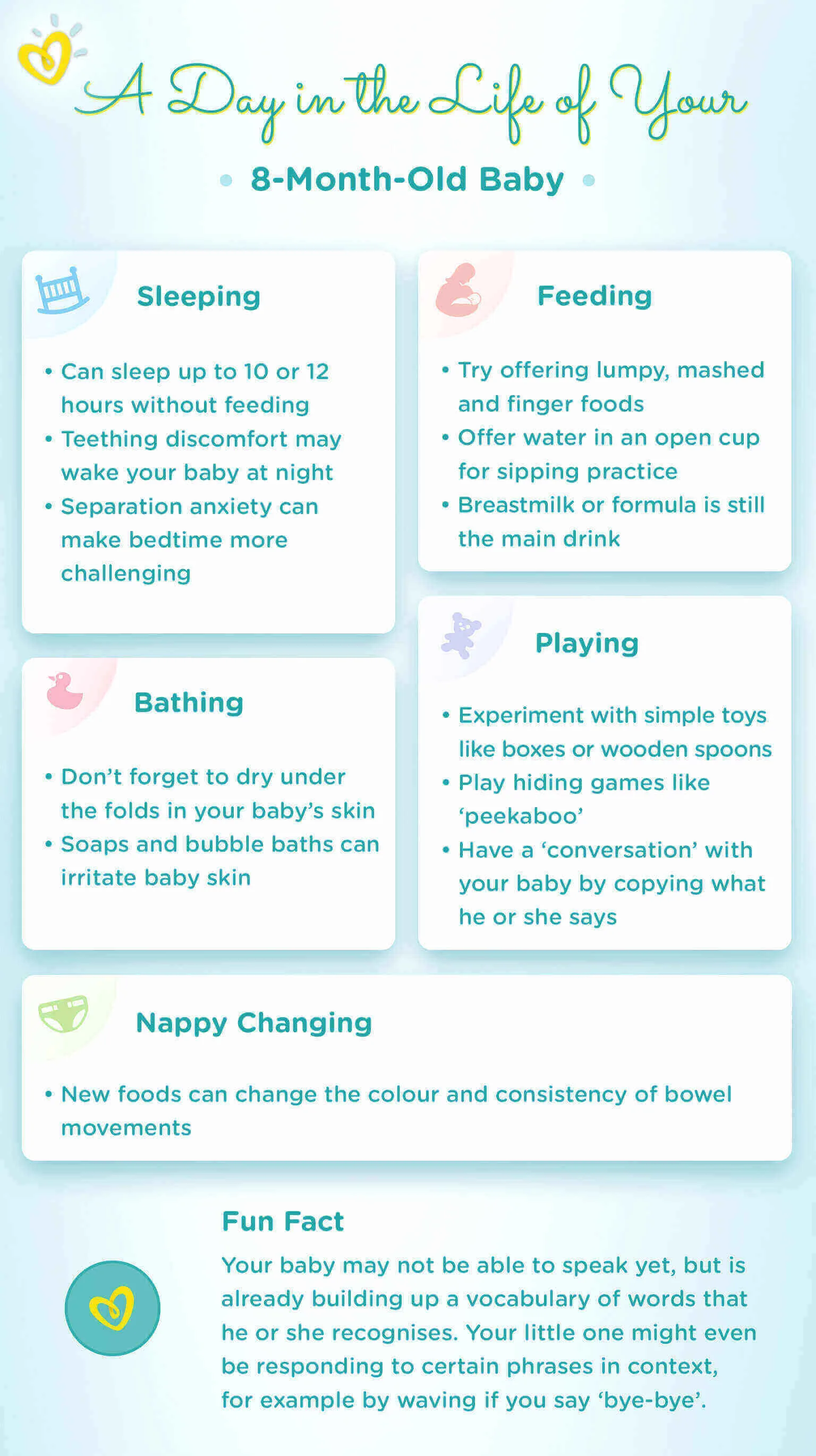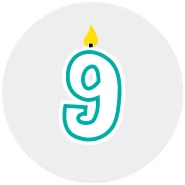8-Month-Old-Baby: Big Moves Ahead
Now that your baby has turned 8 months old, you may be finding that he or she is more curious and active than ever before. Those muscles are getting stronger, and your little one’s getting ready to use those legs for crawling, scooting and eventually walking. Here's what you need to know about sleeping, feeding, health concerns and more so you’ll be prepared for what might come during this exciting time of growth and development.

Baby Development Milestones
You're about to see some big changes! If your baby hasn't started crawling yet, he or she might now be starting to. Whether your little one does start crawling or skips this stage entirely and goes straight to walking down the track, he or she'll be on the move before you know it! It might surprise you that your baby’s sleep habits may change this month. Your little one is also likely to be growing more attached to you and other caregivers. For more on all this and more, keep reading.
Physical Development: Putting His Best Foot Forward
Have you taken a good look at your baby’s feet lately? You may notice that those little feet and toes may point inward when your little one is lying on his or her back; then, when he or she starts to take those first steps, the toes may point outward. Not to worry, those foot positions will correct themselves in due time. In-toeing (also known as pigeon toes) is a condition where a child's feet turn in. It usually corrects itself by the age of eight, and treatment isn't usually needed.
Movement: Preparing to Crawl
At 8 months old, your baby has probably already mastered sitting up without any help. Watch as he or she starts to lean forward to reach for and pick up objects with one hand! Right now, your little one is working on strengthening the muscles that are needed for crawling, which usually starts somewhere between 7 and 10 months. Now that your baby is more mobile than ever, it's even more important to keep a close eye on him or her, especially during nappy changes or at play time.
One way to help your little one get ready to crawl is by giving him or her plenty of tummy time. During tummy time, your baby is in the perfect position to start crawling, and learning how to push up onto his or her hands and knees. He or she may start by rocking back and forth before getting the hang of propelling him or herself forward. You can give even more encouragement by holding a toy or other object just beyond his or her reach.
Cognitive Development: Playing With Words and Sounds
Your 8-month-old baby's language and communication skills are continuing to develop, and you may find you both understand each other a little bit better these days. In fact, what may have sounded like gurgles and babbles until recently can begin to sound like real syllables. Simple syllables like ‘ma’ and ‘ba’ start to form the basis for simple words, like mama and bye-bye.
Your baby now understands more of your words, too! If you mention a favourite toy that’s across the room and your little one looks in its direction, he or she is understanding you. Your baby might also be starting to respond to his or her own name and the word ‘no’, too.
Separation anxiety is not uncommon at this stage. Your little one is still learning that objects (and people) continue to exist when out of sight, so your absence may cause him or her some stress. And, with little or no concept of time, your baby can't figure out when or even if you'll return. You may be able to help your little one through these periods of separation anxiety with a transitional object, like a security blanket or a special, favourite toy for comfort and reassurance.

How to Support Your Baby's Development
There are lots of ways to encourage your baby's intellectual and physical development. Your little one is curious, increasingly mobile, and eager to enjoy new experiences with you. Here are a few tips for helping this along:
Keep talking. By introducing new sounds, syllables, and simple words, you can encourage your baby to repeat what he or she hears. Point out things to him that you can both see, for example ‘Look, there’s a red car!’
Play peek-a-boo. This simple game can provide endless entertainment and giggles, and you can take turns ‘finding’ each other under a soft cloth.
Get creative with toys. Remember, toys for your 8-month-old baby don't need to be fancy. Babies can find a plastic container and a wooden spoon just as fascinating as some expensive gadget.
Get on your baby’s level. Quality time spent playing together on the floor is great for your little one’s development. Try rolling a ball back and forth and watch as he or she gets more skilled at this activity.

Feeding Your 8-Month-Old Baby
Now that your baby already enjoys a whole range of solid foods, continue to offer him new flavours and textures from all four food groups (starchy foods; fruits and vegetables; meat, fish and eggs; dairy) daily.
Giving your baby lots of variety may have the added benefit of making your baby less likely to be a fussy eater later. This is because babies are more readily accepting of new tastes and textures early on. Don't worry if your little one doesn't take to a new flavour right away. Your baby may need repeated exposure to a new food before going ahead and eating it. Keep in mind, giving solids doesn’t mean you should stop breastfeeding. You can carry on as long as you and your baby want to.

How Much Sleep Does a 8-Month-Old Baby Need?
By now, your 8-month-old baby may be sleeping about 11 to 12 hours at night and napping for about 2.5 to 3 hours during the day. This might sound like a lot of snoozing, but be prepared for some disruptions in your baby’s sleep routine around this time.
For some little ones, the onset of separation anxiety at this stage can lead to sleep regression, meaning your 8-month-old baby may sleep less than he or she used to, or may wake in the night after previously being able to sleep right through until the morning.
Here are some tips to help your little one sleep more soundly:
If your baby has a separate room or nursery, put him or her to bed with the bedroom door open. Your little one may feel more comfortable if he or she can hear you, and won’t feel completely closed off.
Provide a transitional object like a small blanket or special toy to help your baby soothe him or herself in your absence. This security blanket will be something your little one has developed a particular attachment to, and it will help remind him or her that everything is OK.
If he or she does cry for you in the middle of the night, try not to turn on the bedroom light, rock or walk with your baby. Also, avoid feeding your little one at these times and taking him or her into your bed. All of these will make self-soothing more difficult in the future, because your baby will come to expect them as part of the bedtime routine every single night. Instead, offer a pat on the back and a few consoling words.

A Day in the Life of Your Baby
Every baby is different, but here’s a glimpse of what a typical day could look like with your baby.

Your Baby's Health: Staying Safe at Home
All that wriggling and moving has been preparing your baby to take those first big steps, and it's important to make sure your home is as safe as it can be for your little explorer. You may have already started babyproofing your home but, if not, now is a great time to start.
Falls
Falls are among the most common household accidents, so you'll want to check your baby's cot, changing table, high chair and any other baby gear to make sure they meet safety standards and are assembled correctly. Here are some more tips:
Never leave your baby unattended on a raised surface because he or she can roll off and get hurt.
Always place baby car seats or bouncing cradles on the floor instead of a table or kitchen counter. This way, your baby will be less likely to get hurt by falling even if all that wriggling tips them over.
Keep low furniture well away from windows, cover gaps between banisters or balcony railings if the bars are more than 6.5cm apart and remove any item from the cot your baby can use to climb on and out of the cot.
Use a three or five point harness to strap your baby into a high chair, push chair or car seat whenever you use them.
Install safety gates at the top and bottom of stairs, and keep them shut.
Water Safety
Drowning can be fast and silent, without any sounds of splashing, coughing or struggle. Babies and small children can drown in as little as 3cm of water, so you'll want to be especially careful in the bathroom, as well as outside if your home has a pool, pond, hot tub, or other small body of water. Never leave your baby alone in the bath, or around any open containers of water such as buckets and watering cans.
If you have a swimming pool, install a fence with a self-closing gate around the entire area. Fence off, fill in or cover any ponds you may have in your garden. Always watch over your baby in the paddling pool, and empty it right after use. Many babies love the water and you can have tons of fun splashing around, but always give your little one your complete attention whenever her or she’s anywhere near water, and try to eliminate anything that might distract you.
Scalding and burning
Your baby’s skin is thinner and burns more easily than an adult’s, so it’s important to take extra care to protect your little one from being burnt or scalded. At bath time, check the temperature of the bathwater with your elbow before putting your baby in the bath and don’t let him or her play with the hot tap. Don’t leave hot fluids within reach of little hands, or let anyone hold your baby while having a hot drink. Keep matches and lighters safely out of sight and reach of your little one.

FAQs at a Glance
By this time, your baby will probably enjoy eating a wide variety of puréed, mashed and soft finger foods including porridge or unsweetened cereal mixed with whole milk or whatever other kind of milk your baby usually drinks, rice, scrambled eggs, mashed chickpeas or peas, minced chicken, mashed canned salmon, vegetable casserole, baked beans or small pieces of ripe peeled fruit.

Your Life as a Parent: Introducing a New Sitter and Handling Weaning
If you've been breastfeeding, you may find that around the time when your baby is starting to sample different foods, he or she may be less interested in breastfeeding. This is called natural weaning and it's perfectly fine to let your baby's preferences take the lead. Continue to offer her new food options while still allowing your little one to breastfeed on demand.
Some mothers face pressure to wean their babies for a variety of reasons, including a lack of support and encouragement from family and friends, or even a lack of facilities for expressing and feeding at their workplaces. The decision to wean is an intensely personal one, but it’s still advisable to breastfeed exclusively for the first six months of your baby’s life and continuing while providing other foods for at least the next year or even two. Consult with your baby's health visitor, child centre, GP, or a lactation consultant for advice on weaning.
As long as you're confident that your baby is getting all the necessary nutrients, there’s no need to feel any pressure to wean if the time doesn't feel right for you and your little one.
Checklist for This Month
Get prepared for the month ahead. Learn about what's coming for you and your baby when she’s nine months old.
For even more information, sign up to get our regular emails:
8 month old baby - checklist
How we wrote this article
The information in this article is based on the expert advice found in trusted medical and government sources, such as the National Health Service (NHS). The content on this page should not replace professional medical advice. Always consult medical professionals for full diagnosis and treatment.







